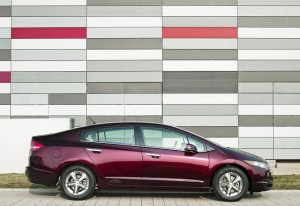This Honda FCX Clarity is the Japanese firm's idea of the future of motoring. It's technically very impressive, but there are some major hurdles to overcome if it's ever to become a mainstream production reality.
In the Metal
The Honda FCX Clarity is a hydrogen fuel cell car. That means it generates its own electricity by using a tank of hydrogen to feed the fuel cell. This all takes place in a box about the size of a small suitcase. According to Honda that means the designers have free reign with the Clarity's design, unrestricted by the packaging constraints that conventional powertrains deliver. It's difficult not to be slightly disappointed as a result, as the FCX Clarity looks like a big Honda Insight. That's likely to be down to the wind tunnel and the quest for ultimate economy, but given that this is a serious look into the future it all appears a bit ordinary.
Inside it's a bit more Buck Rogers; as modern as a dashboard resembling a disco-lighted, digital graphic equaliser front of a Awia mini-hifi circa 1990 is.
What you get for your Money
The car you see here is one of just 35 FCX Claritys to have been built on a dedicated production line. Honda has been building the FCX Clarity since 2008, so it's safe to say it isn't popping off the production line at the same rate as the Jazz or Civic. Being largely hand built, the fuel cell technology so advanced and the materials within it so expensive, the FCX Clarity should come with a sticker price with six zeros. Instead it's being leased to companies and individuals as part of Honda's trialling of the technology. Consider that and the leasing costs of about €450 a month are quite inexpensive. You can't have one in this part of the world though, with leased Claritys being limited to California and Japan for now.
Driving it
The FCX Clarity uses technology that NASA uses to power space stations, with hydrogen cleverly turned into electricity by use of a fuel cell. What's impressive is that it drives like an ordinary car. Pop the unnecessarily over-designed automatic gear selector into drive and you're off. Quietly. Like all electric vehicles the FCX Clarity is near silent on the road. It rides decently enough, the steering is a bit vague and the brakes a bit wooden, but in the five miles or so we drove it the FCX Clarity felt entirely production ready.
Unlike conventional plug-in electric vehicles the FCX Clarity has a decent range - around 435 kilometres. To go further you need to fill it with hydrogen, which is where the problem lies, as there's no hydrogen filling network in Ireland. There's one emerging in Germany, while Japan and California are also pushing ahead with infrastructure, but otherwise the FCX Clarity is stuck in a tricky future tech Catch-22.
Worth Noting
Hydrogen might be one of the most abundant elements on the planet, but its production into a form for consumption currently comes with a big CO2 penalty. Obviously Honda is pushing more sustainable methods of production, but presently only around two percent of hydrogen production can be called 'green'. It'll need a seismic shift in methods if fuel cell cars are to credibly replace current internal combustion engined cars - rather than merely push the CO2 production and fossil fuel consumption further up the supply chain.
Summary
Given that production fuel cell vehicles have been 'twenty years away' for a long time now, the fact that Honda has achieved the production of one is very impressive indeed. It sees the FCX Clarity as the future, and certainly it removes the slow charge, low range issues of conventional plug-in electric cars. With that it brings its own problems, chiefly the green production, distribution and availability of the hydrogen required to fill it. If those not insignificant hurdles can be conquered then fuel cells represent a brilliant future solution for clean motoring, but we might be waiting 20 years or more yet still and battery charge times, performance and range is getting ever better with conventional electric vehicles.


